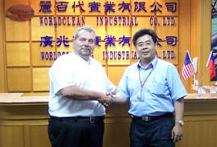
-----
Not very successful yet at anodizing
Q. My employer has recently decided to take up anodizing as an extension of the business, and has appointed me as the anodizer. None of us had any knowledge of the process until we bought an anodizing kit from Caswell. I have adapted the Caswell process based on my independent research on this site and others, bit I haven't managed to correctly anodize a single part after over a month of trial and error.
I have tried everything I have seen, including raising and lowering the amperage current beyond that suggested by a 720 calculator, raising and lowering the temp of the dye bath and sealing bath, and allowing more and less time (15 minutes up to an hour) in the anodize bath, all of these in as many combinations at math allows.
My process is as follows:
1 15-20 minutes in a degreaser bath, degreaser supplied by a hobby plating supplier
2 3-5 minutes desmut, also supplied by the hobby plating supplier
3 variable time in a 3/1 water/sulfuric acid bath at 60 °F
4 acid neutralize in water+baking soda [in bulk on
eBay
or
Amazon [affil link]
5-ish minutes
5 20-30 minutes in a 140 °F dye (I've been using black)
6 10-20 minutes in a sealant bath, also supplied by the hobby plating supplier
I've been stripping and redoing the parts over and over, buffing with scotch brite before restarting the process.
I use titanium wire and a copper pipe as a hang bar, and I attempt to get as good a connection as possible with bending the wire to hold itself inside holes in the part
My work environment is a repurposed garage, kept dry by heaters. I open the garage door for ventilation
I have had trouble with the power supply, it's a Tekpower 3030e, and the manual does not describe how to use it, but I can set the voltage. There doesn't appear to be a way to set the amperage, which it does display.
When my parts do appear dark and anodized, they always have a horizontal white-ish line on them. It is always perfectly horizontal, regardless of how the part is hung. This leads me to believe there is a problem with my tanks themselves. They are 5 gallon buckets, heated by industrial heating elements.
My anodize tank has 2 square sheets of equally cut lead hung from either side, pressed to the inside of the bucket so the parts don't touch them. They reach nearly to the bottom of the tank from the top, further than any part hangs.
I also have copper colored patches that appear all over the parts.
I have been told I'm using 6061 aluminum
I remake all the baths every ten runs or so
I feel as though I am wasting my employer's time by being unable to figure this out, and I do not believe this will be profitable if it is truly this difficult, so I hope I am just doing something wrong.
- Springfield, Missouri
April 7, 2023

Aluminum How-To
"Chromating - Anodizing - Hardcoating"
by Robert Probert
Also available in Spanish
You'll love this book. Finishing.com has sold almost a thousand copies without a single return request :-)
A. Hi Aramis. I sympathise with the position you are in where you've never anodized, you have no help, you have a power supply which you don't know how to operate and which may be defective, you have no capacity to analyze the chemistry, you're using bargain basement equipment, the aluminum may not actually be stripped each time you re-do it, the titanium wire may not be making proper contact or may not be heavy enough gauge, and you're not sure of the alloy.
I think step one is to send the piece to an anodizing shop to verify what should be achievable. Also, start by telling us how large the piece is, and and what voltage and current you are recording.
And do whatever is necessary to learn how to operate the power supply (assuming it's not defective), starting with Ohm's Law (i.e., understand that you cannot control Volts and Amps separately; you choose one or the other). I don't have a manual for that power supply, but often you press buttons in the middle of the knobs to switch from voltage control to amperage control. Usually the displays work like modern-day digital thermostats work -- while you're adjusting them they read what you are setting them for, not the actual voltage or current that is being drawn; then after you stop fiddling with the dial for a few seconds they revert to showing you what you are actually drawing. So perhaps you press the button in the middle of the amperage knob, turn it to say 3 Amps depending on the size of the part, and watch it draw 3 Amps at a couple of volts, and hold 3 Amp as it gradually increases the Voltage to continue anodizing as the resistive anodized film grows.
Luck & Regards,

Ted Mooney, P.E. RET
Striving to live Aloha
finishing.com - Pine Beach, New Jersey
Ted is available for instant help
or longer-term assistance.
A. Several issues you need to work on ASAP before you can have any real hope of getting acceptable results, in no particular order:
1. You do not mention any rinsing, parts need to be thoroughly rinsed before each step.
Normal practice is to use deionized water, but for initial testing city (tap) water should be ok.
2. You must know what current is flowing to the parts in anodize bath.
If you have any doubts about the operation of your power supply, obtain a cheap multimeter and connect it in series between the power supply and the part(s).
Best anodizing method is by "constant current", if your power supply does not allow that it will be much more difficult (but not impossible) to obtain good results.
3. Anodize bath MUST be agitated (stirred/mixed) at ALL times while current is flowing.
This is probably the cause of your "horizontal lines", there is heavy heat buildup which cannot be dissipated due to no/ineffective mixing.
The usual way of doing this is with compressed air (must be oil-free) fed into a submerged pipe with holes drilled in it. Aquarium air pumps etc. are quite marginal even for a small bucket.
4. For any "production" work it is critical to have a refrigeration system to maintain constant bath temperature. Anodizing process is very sensitive to temperature variations.
For test purposes, you can do without refrigeration if you anodize tiny part in a huge bucket.
And do not even think about putting ice cubes in the bath, it will dilute the acid and ruin everything.
5. You mention 3/1 water/sulfuric ratio, is that by weight or by volume?
If it's by volume, that's almost 2x too much acid and it will not work.
6. Parts must have very good electrical contact with titanium wire. Simply hanging the part on the wire (typical electroplating practice) will never work for anodizing unless the part is extremely heavy.
You need to bend the wire so that it "bites" into the part at the contact points, and the part must not be able to move relative to the wire.
Your "copper colored patches" are a clear indication that your parts are losing contact with the wire partway during the anodize process.
- Czestochowa, Poland
April 18, 2023
adv.
Call me and I will try to get you on the correct path FREE
843-832-8931

Drew Nosti, CEF
Anodize USA
Ladson, South Carolina

May 10, 2023
A. Hi Aramis!
Did you ever precondition your bath with scrap aluminum? You say you keep remaking your bath. But you may be shooting yourself in the foot! You gotta aim for about 10 ppm aluminum contamination, which is a GOOD thing! Fresh clean sulfuric acid isn't enough to start your build.
Run a titration that gives both your sulfuric concentration and your aluminum "contamination".
You will need:
phenolphthalein indicator, usually sold in some sort of alcohol, concentration unimportant.
Sodium hydroxide 1N. Grainger sells it cheap.
potassium fluoride
⇦ on
Amazon [affil link]
10-20%, also not a big deal since the titration puts it in in excess. Another common chemical from supply houses.
You want 172 g/L +/- 5 sulfuric acid and at least 8 but no more than 15 g/L aluminum to set your anodize solution correctly.
Don't remake from scratch. You lose that sweet sweet aluminum "heel".
I posted a titration calc somewhere on here, you can probably find it in the lab section.
If I know I need to make a new tank, as I do now due to a chiller leak... I save a bunch of "spent" acid from a tank that was decanted due to too much aluminum as a seed. Otherwise, go dig up some scrap aluminum and just let it soak over a weekend, testing occasionally, until you hit that 8 g/L.
Cheers

Rachel Mackintosh
Lab Rat / WWTF - Greenfield MA
June 9, 2023
Q, A, or Comment on THIS thread -or- Start a NEW Thread
